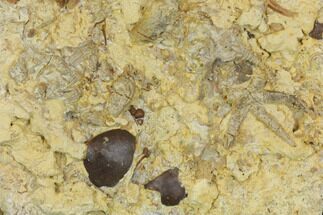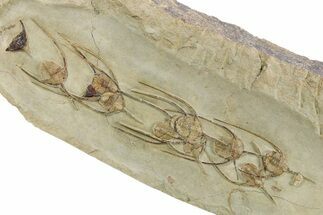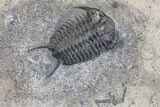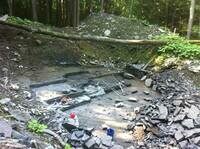This Specimen has been sold.
7.6" Plate of Four Ceraurus Trilobites - Walcott-Rust Quarry, NY
This is a 7.6" wide plate containing four mostly complete Ceraurus pleurexanthemus trilobites as well as several crinoid stems and bryozoan specimens that have been partially exposed. It was collected from the famous Walcott-Rust Quarry in New York. The largest trilobite measures 1.25" wide (genal spine to genal spine)
There is a repaired crack through the rock. Comes with a display stand.
There is a repaired crack through the rock. Comes with a display stand.
The
Walcott-Rust quarry, located near Russia, NY, is one of the most historic trilobite collecting localities in the world. It was first worked by famed paleontologist Charles Doolittle Walcott along with William Rust in 1870. It was where Walcott was first introduced to trilobites; he later went on to make many amazing discoveries with the arthropods across North America, including the famed Burgess Shale. This quarry was lost for over a century, but later rediscovered in the 1990s by Thomas Whitely, who dug and researched the site heavily. It's now leased by Trilobites of America, LLC. Not only does it produce some of the most amazing trilobites found in the US, but outstanding new contributions continue to be made to science.
The limestones of this quarry produce arguably the best preserved trilobites in the United States, many of them perfectly three-dimensional with no compaction at all. These include types like Ceraurus, Isotelus, Flexicalymene, Sphaerocoryphe, and many more. Collecting the Walcott-Rust quarry is brutally hard. It requires extracting large blocks of solid limestone, often weighing several hundred pounds, using massive pry bars, 20-pound sledge hammers, wedges, a lot of brute force, and rock quarrying know-how. These large blocks are then broken down into smaller and smaller pieces, looking for cross sections of the black trilobites in the black rock (a nearly impossible task). When a trilobite is found the real work begins, painstakingly extracting it from its limestone tomb under high-powered microscope using air scribes and abrasives.
The limestones of this quarry produce arguably the best preserved trilobites in the United States, many of them perfectly three-dimensional with no compaction at all. These include types like Ceraurus, Isotelus, Flexicalymene, Sphaerocoryphe, and many more. Collecting the Walcott-Rust quarry is brutally hard. It requires extracting large blocks of solid limestone, often weighing several hundred pounds, using massive pry bars, 20-pound sledge hammers, wedges, a lot of brute force, and rock quarrying know-how. These large blocks are then broken down into smaller and smaller pieces, looking for cross sections of the black trilobites in the black rock (a nearly impossible task). When a trilobite is found the real work begins, painstakingly extracting it from its limestone tomb under high-powered microscope using air scribes and abrasives.
SPECIES
Ceraurus pleurexanthemus
AGE
LOCATION
Walcott-Rust Quarry, Russia, New York
FORMATION
Trenton Group, Rust Formation, Spillway Member
SIZE
Largest Trilobite 1.25" wide, Plate 7.6 x 7.4"
CATEGORY
SUB CATEGORY
ITEM
#138810
We guarantee the authenticity of all of our specimens.
 Reviews
Reviews





















